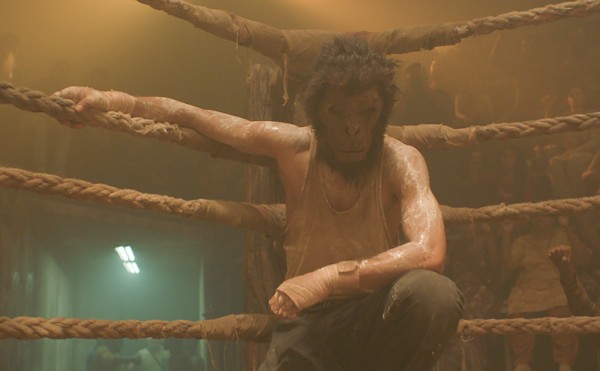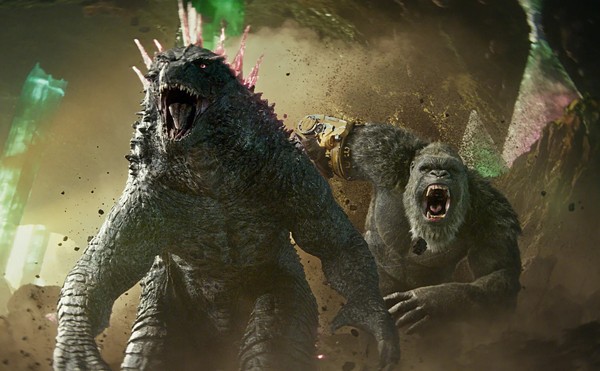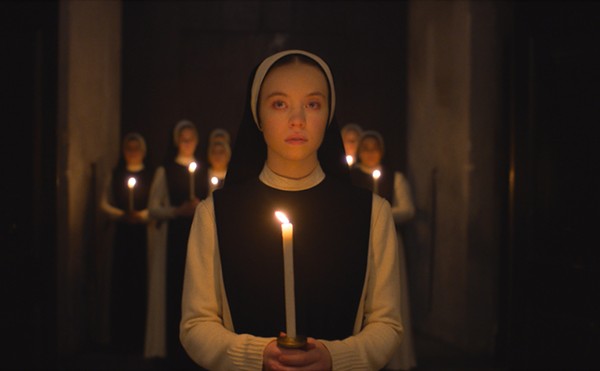In 1973, France was still recovering from the effects of a second revolution, the political one that had carried its people to the barricades and brought the country to a standstill for a few short but heady weeks in May 1968. These overwhelming and even contradictory ideas -- the feeling that society was changing and that new rules for behavior were being invented and old ones being tossed aside; the sense that cultural objects such as movies, books, music, philosophy could be felt as strongly as historical and material ones -- were still in the air when Jean Eustache made what might be the definitive account of post-New Wave, post-'68, post-everything society, The Mother and the Whore (New Yorker).
Making its long-awaited video debut (as far as I know, the film has never been screened publicly in St. Louis), Eustache's film is a haunting, disturbing and even irritating work but is by no means a simple one. Running more than three-and-a-half hours and filmed in black-and-white, the movie consists almost entirely of conversations among three people. It's indebted to the New Wave, perhaps most particularly to Eric Rohmer's 1969 film My Night at Maud's, a philosophical dialogue disguised as romantic drama, but the unresolved nature of the issues it raises -- and its continuing influence on young French filmmakers -- keeps it disturbingly contemporary. Indeed, the almost embarrassing frankness and raw emotion of the film transcend fashion and history. When the New Wave directors speculated on the cinema's ability to merge with everyday life (as in Truffaut's repeated question "Are movies more important than life?" in Day for Night or Godard's invocation of "the film that we wanted to make, and, more secretly, wanted to live" in Masculine-Feminine), this may have been what they had in mind.
Jean-Pierre Leaud, a New Wave icon by virtue of his recurring role as Truffaut's autobiographical hero Antoine Doinel and several collaborations with Godard (both of the quotations above are, in fact, spoken by Leaud), plays Alexandre, an immature, spoiled Parisian intellectual who is more comfortable dealing with abstract ideas than confronting real emotions. He lives with -- and is supported by -- Marie (Bernadette Lafont), though neither is exclusively interested in the other. Rejected by a former girlfriend, he meets Veronika (Françoise Lebrun), a compulsively promiscuous nurse. Though much of the film could be described as their love story, it's their tragic lack of a common ground, their sheer inability to penetrate the reserve of the other, that sets the drama in place.
To describe the plot in greater detail is unnecessary; The Mother and the Whore is about relationships that will never be settled, disputes that will never be solved, wounds that will never heal. Will any of these characters ever learn how to get what they want? Will they even know where to look? The title refers not to the two women or the roles they play in Alexandre's life -- or even to the roles he expects them to play. Rather, it's a measure of possible roles, of the traps of identity that are set before each character. Veronika may be most vulnerable to their influence; her tearful, pained monologue rejecting them is the film's most searing moment.
In some respects, The Mother and the Whore is about a generation -- or a society -- tricked by its own illusions. Alexandre, Marie and Veronika have learned how to see through romantic conventions but not how to replace them. They're trapped, victims of their own cleverness. Will they ever reach a satisfactory conclusion or find the definitive answer to the problem of their relationships? Eustache -- who committed suicide in 1983 -- raises all of these questions, but the film's bitterness comes from showing that there are no obvious answers.
POLE VAULT: In 1914, just five years after man first reached the South Pole, Sir Ernest Shackleton led 27 men on a grueling and heroic mission without equal in the history of polar exploration. His ship, Endurance, became trapped in ice for eight months before finally being crushed, leaving the men to travel on ice floes for another five months, after which Shackleton and a small crew set out on an 850-mile mission across water, land and up the side of an iceberg to find help. The adventure was recorded in South: Shackleton and the Endurance Expedition (now available from Milestone Home and Video at 800-603-1104), a newly restored 1919 documentary that features images as breathtaking as they are eerie. Though it wanders off into travelogue toward the end, expedition member Frank Hurley's account depicts a world not quite like anything ever filmed before, a blend of boy's-book adventure and dreamlike fantasy. (For those truly fascinated by the poles, Milestone also offers the film in a boxed set with two more excellent exploration films, 90 South: With Scott to the Antarctic and With Byrd at the South Pole.)
GETTING THE BUGS IN: In the early days of widescreen movies, producers actually shot two versions of the same film, one for theaters equipped for Cinemascope and another in standard format. (For those not up on movie technical data, widescreen processes like Cinemascope and Panavision create an image that is 2.35 times as wide as it is high, whereas the traditional Academy ratio was 1.33:1, approximately the dimensions of a TV screen.) The computer-animation pioneers at Pixar have added a new twist to the process in preparing a full-screen version of A Bug's Life for video: Rather than go through the usual process of scanning the film and dropping off nearly half the image, they used the original computer data to create a new 1.33 version that reconfigured all of the important visual components. (If you're interested in making a comparison, a letterboxed version is also available; the DVD contains both.) It's an interesting idea, but how many other film producers have the luxury of keeping the entire cast and sets on their hard drives when it comes time to prepare video transfers? Speaking of Pixar, the video also contains their marvelous Oscar-winning short "Geri's Game," possibly the finest example of computer animation to date.
And speaking of letterboxing, someone could teach the folks at Simitar Home Video a thing or two about screen size: They recently released The Thin Red Line -- not last year's Terence Malick film but the 1964 version starring Keir Dullea. Their "letterboxed" version takes the original Cinemascope frame and squeezes it into a 1.85 frame, making it suitable only for those who have always wondered what the landing at Guadalcanal might have looked like in a funhouse mirror.
SHELF LIFE: The ghosts of Warhol, Wilde and Marc Bolan smile down on the most original movie of 1998, Todd Haynes' science-fiction/glam-rock musical/ film à clef Velvet Goldmine (Buena Vista Home Video). It's rental-only now, but save your pennies and hope for a letterboxed sell-through version later this year....
Three montage classics of Soviet silent cinema, Sergei Eisenstein's Strike, Dziga Vertov's Kino-Eye and Aleksandr Dovshenko's Arsenal, all newly restored (or, in the case of the Vertov film, pieced together from the few materials that remain), are now available from Kino on Video.... First Run Features' series of artsy '60s soft-core Euro-porn continues with a pair of films from Jose Benazeraf, The Fourth Sex and Sexus, the latter having nothing to do with the Henry Miller novel of the same name but boasting a musical score by Chet Baker.
Just out are two of the most highly praised (but barely seen) imports of recent years, Abbas Kiarostami's Taste of Cherry (Home Vision Cinema) and Bruno Dumont's tough (if misleadingly titled) Life of Jesus (Fox Lorber). Also on the international front: Russia's Academy Award-nominated The Thief (Columbia Tristar) and a timely story of an American soldier in Bosnia, Savior (Columbia Tristar), starring Dennis Quaid and produced by Oliver Stone.... Originally produced by Motown and reissued by Quentin Tarantino (who also slipped a scene into Jackie Brown), the 1973 Detroit 9000 (Buena Vista Home Video, rental only) is neither pure blaxploitation nor straight cop action, instead choosing to casually play its race card from both sides. Alex Rocco plays a frustrated, street-smart cop forced to accept the Shaft-like Hari Rhodes as his partner on a highly publicized robbery case. The film wears its racial compromises as heavily as do its heroes, and it's less energetic than the average New World production of its time; as '70s drive-in fodder goes, it's less an undiscovered classic than a pleasant late-night diversion. Still, veteran actor Rocco (the next candidate for B-movie career recovery, now that Robert Forster has been thoroughly revived) has probably never been better.





